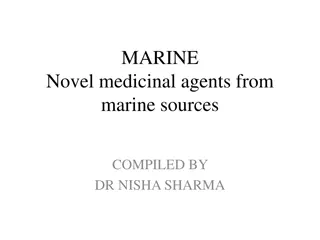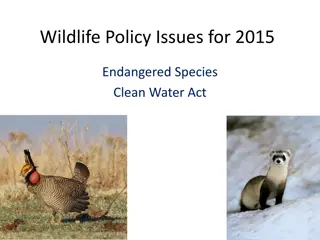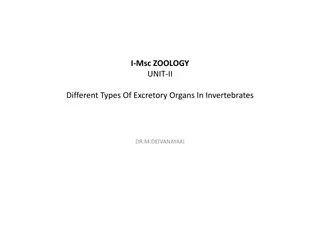Understanding Freshwater Biodiversity: Invertebrate Bio-indicators
Explore how invertebrates like stoneflies, mayflies, and caddisflies can be used as bio-indicators to determine water quality in freshwater habitats. Each species has specific environmental requirements, making their presence or absence a valuable tool for assessing the health of freshwater ecosyste
0 views • 16 slides
Understanding Retrogressive Metamorphosis in Ascidian Tadpoles
Retrogressive metamorphosis in ascidian tadpoles involves a unique transformation where advanced larval features are lost during development, leading to a sedentary or degenerated adult form. Ascidians, also known as sea squirts, exhibit this type of metamorphosis, shedding their chordate characteri
1 views • 24 slides
Marine Novel Medicinal Agents from Marine Sources Compiled by Dr. Nisha Sharma
Oceans, covering more than 70% of the Earth's surface, harbor a plethora of invertebrates and algal species, providing a rich source of medicinal compounds. Marine organisms have yielded commonly used drugs like shark and cod-liver oils, sodium alginate, agar-agar, and chitin. Various classification
1 views • 9 slides
Overview of Arthropods: Classification and Characteristics
Arthropods are a diverse group of invertebrates characterized by segmented bodies, appendages, and chitinous exoskeletons. They belong to the Phylum Arthropoda and are classified into four important classes: Myriapoda, Crustacea, Arachnida, and Insecta. This article explores the unique features of e
0 views • 18 slides
Benefits of Mycorrhizae in Plant Nutrition and Ecosystem Health
Mycorrhizae play a crucial role in enhancing plant nutrient uptake, protecting against pests, improving plant growth, and fostering ecosystem stability. These symbiotic relationships provide various benefits such as increased nutrient supply, protection from pathogens, enhancement of plant growth fo
0 views • 9 slides
Fisheries and Aquaculture in Vanuatu: Sustainable Development and Management
Vanuatu aims to ensure sustainable exploitation of fisheries resources, maximize economic and social benefits, contribute to food security, and meet regional responsibilities through its fisheries sector. The country's Exclusive Economic Zone (EEZ) covers 668,220 km2, with key features including a r
0 views • 17 slides
U.S. Caribbean Reef Fishery Management Plans Amendment Summary
Amendments were proposed in June 2016 to the U.S. Caribbean Reef Fish, Spiny Lobster, and Corals And Reef Associated Plants and Invertebrates Fishery Management Plans. The focus was on the timing of Accountability Measure (AM)-Based Closures, with two key actions: modifying the implementation timing
0 views • 12 slides
Starfish: Fascinating Echinoderms of the Ocean Depths
Starfish, also known as sea stars, are marine invertebrates belonging to the class Asteroidea. With roughly 1,500 species found worldwide, these creatures play essential roles in various ecosystems. Their unique anatomy includes a water vascular system for movement and feeding. Starfish have intrica
0 views • 6 slides
Understanding Unicellular and Multicellular Organisms in Biology
Explore the basic differences between unicellular and multicellular organisms, including the distinctions between prokaryotes and eukaryotes. Unicellular organisms, such as bacteria and amoeba, consist of a single cell and are often microscopic. Examples of both prokaryotic and eukaryotic unicellula
0 views • 10 slides
Understanding the Classification of Living Organisms
Living organisms are classified into five kingdoms, each further divided into smaller groups called phyla, classes, orders, and genus. The five kingdoms are Monera, Fungi, Protista, Plantae, and Animalia. Animals are categorized into invertebrates and vertebrates, with significant agricultural impor
0 views • 50 slides
Understanding Circulation and Gas Exchange in Living Organisms
Explore the diverse circulatory systems in invertebrates and vertebrates, from jellyfish to humans. Learn about open and closed circulatory systems, the structure and function of the heart, heart valves and sounds, as well as how heart rate and cardiac output are measured.
0 views • 11 slides
Wildlife Policy Issues for 2015: Endangered Species & Clean Water Act
Overview of policy issues surrounding endangered species and clean water act in 2015, including definitions, history, causes of endangerment, petition and listing factors. Focus on protecting species like the Lesser Prairie Chicken and Black-footed Ferret. Mention of Kansas' threatened and endangere
0 views • 21 slides
Medical Invertebrates Course Overview
This course on Medical Invertebrates, led by Prof. Dr. Ola A. Abu Samak, provides an in-depth exploration of various invertebrate animals, their anatomy, physiology, and medical significance. Students will learn about the natural history, taxonomy, and infectious diseases of invertebrates, utilizing
0 views • 12 slides
Amendments to U.S. Caribbean Fisheries Management Plans - December 2015
Amendments were proposed for the U.S. Caribbean Reef Fish, Spiny Lobster, and Corals and Reef Associated Plants and Invertebrates Fishery Management Plans in December 2015. The amendments focused on modifying the timing of accountability measure-based closures and specifying the frequency of reviewi
0 views • 14 slides
Animal Kingdom Vocabulary Review Game
Test your knowledge of the animal kingdom with this vocabulary review game. Answer questions about invertebrates, vertebrates, and different types of animals to earn points for your team. Stay sharp to win classroom cash!
0 views • 32 slides
Understanding the Role of Soil Biology in Lawn Care
Soil biology plays a crucial role in maintaining healthy and vibrant lawns. Various organisms, including invertebrates, plant roots, mycorrhizae, and micro-organisms, contribute to functions such as soil structure maintenance, regulation of soil hydrological processes, gas exchange, carbon sequestra
0 views • 27 slides
Overview of Different Excretory Organs in Invertebrates
In invertebrates, there are various types of excretory organs such as the contractile vacuole, nephridium, renal gland, coxal gland, and Malpighian tubule. These organs play crucial roles in osmotic regulation and nitrogen excretion. Different phyla exhibit diverse excretory structures like nephridi
0 views • 6 slides
Understanding Animal Skeletons in Grade 5 Natural Sciences and Technology
Explore the fascinating world of animal skeletons in Grade 5 Natural Sciences and Technology. Learn about the differences between vertebrate and invertebrate skeletons, the importance of skeletons in animal movement, and the various types of skeletons found in nature. Discover how vertebrates' skele
0 views • 11 slides
Understanding Animal Skeletons in Grade 5 Natural Sciences and Technology
Exploring the diverse world of animal skeletons, this Grade 5 Natural Sciences and Technology presentation covers vertebrates and invertebrates, showcasing different types of skeletons like endoskeletons and hydroskeletons. Understand the importance of skeletons in supporting movement and protecting
0 views • 11 slides
Explore the Fascinating World of Insects and Animal Classification
Discover the unique characteristics of insects such as their body parts, legs, compound eyes, antenna, and exoskeleton. Learn about the classification of animals into insects and non-insects, as well as vertebrates and invertebrates. Explore how animals can be sorted based on different criteria and
0 views • 35 slides
Exploring Rainforest Animals through Classification and Comparison
Dive into the world of rainforest animals by learning their names, categorizing them into vertebrates and invertebrates, describing their characteristics, creating animal profiles, and comparing their different traits. Develop language skills by expressing opinions, classifying animals, and writing
0 views • 6 slides
Immune Responses in Plants and Animals: A Comprehensive Overview
Plants and animals have evolved a variety of chemical defenses to combat infections and maintain homeostasis. Innate immunity provides immediate protection through barrier and internal defenses, while acquired immunity offers specific responses involving humoral and cell-mediated mechanisms. Plants
0 views • 26 slides
Understanding Environmental Risks of RNAi Technology as a Pesticide
This presentation discusses the environmental considerations and risk assessments associated with RNAi technology as a pesticide, focusing on the unique challenges presented by dsRNA PIPs. Topics covered include ecological risk assessments, nontarget organism exposure, exposure assessments for PIP p
0 views • 13 slides
Animal Life Cycles Review and Group Challenge
Explore the world of animal life cycles through a trivia game and group challenge. Test your knowledge on organisms, embryos, vertebrates, invertebrates, and more. Dive into rounds of tricky taboo questions and identify adult animals from their offspring. Discover common traits among mammals, unders
0 views • 8 slides
Fascinating World of Arthropods: Diversity and Characteristics
Arthropods, the largest phylum in the animal kingdom, exhibit a wide array of characteristics and play crucial roles in various ecosystems. From crustaceans to insects, these invertebrates showcase segmented bodies, jointed appendages, and diverse respiratory systems. Explore the world of arthropods
0 views • 12 slides
























